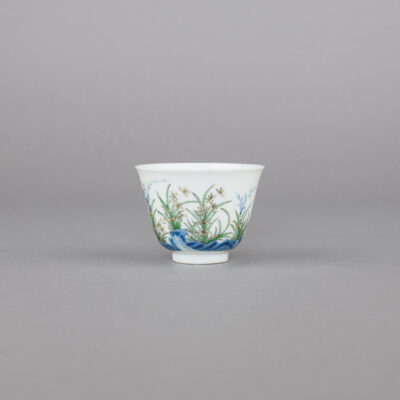9 – SMBM1
Description
Chinese imperial porcelain famille verte month cup, hua shen bei, thinly potted with gently flared rim on a short foot, painted with orchids amongst long green leaves growing from rockwork with branches and grass, the reverse with a ten-character couplet and square seal in underglaze blue.
The base with a six-character mark of Yongzheng within a double ring in underglaze blue and of the period, 1723-1735.
2 9/16 inches, 6.5 cm diameter, 1 ⅞ inches, 4.8 cm high.
Provenance & Additional Information
- Purchased by Richard Marchant circa 1965.
- Included by P. Marchant in a lecture given to the Oriental Ceramic Society of Hong Kong, 23rd November 1976, titled Some Interesting Pieces of Marked Ch’ing Porcelain, Bulletin of the Oriental Ceramic Society of Hong Kong, no. 3, 1977-1978, no. 6 (enlargement), p. 42, where the author compares it to a Kangxi example and notes, “this detail shows the delightful translucent enamels and particularly fine blue. It should be noted that two different colour washes were used; this is another little added touch needing care and patience to recognise”.
- The poem reads guang dian qing xiang fa, gao tai yuan chui yin and translates as “The fragrance spreads through the Grand Hall, while melodies resound from a high terrace”. The seal reads shang, “appreciation”.
- A further example, painted with iron-red and yellow peonies, was exhibited at the Rijksmuseum, Amsterdam, 1954, 357, and sold by Sotheby’s London in their auction of Fine Chinese Ceramics and Works of Art, The Property of H. M. Knight, Esq., 12th May 1970, lot 100; another of the same design was sold by Sotheby’s Hong Kong in their auction of Fine Chinese Ceramics and Works of Art, 20th November 1984, lot 405, purchased by Marchant, and sold again by Sotheby’s Hong Kong in their auction of The Goldschmidt Collection of Qing Imperial Porcelain, 13th November 1990, lot 17; a further example, with peonies, now believed to represent the fourth month, was sold by Sotheby’s Hong Kong in their auction of Important Chinese Art, 9th October 2023, lot 3616, where the catalogue notes, “famille-verte month cups are much more rarely found with Yongzheng than with Kangxi reign marks, and no complete set of Yongzheng cups appears to be recorded”.
- Kangxi month cups of the seventh month are similarly painted with the same poem and
- A complete set of Kangxi month cups, of which nine probably came from Marchant, is illustrated by Yang Boda in The Tsui Museum of Art, Chinese Ceramics IV, Qing Dynasty, Hong Kong, 1995, 105A.
- Another set is illustrated by Regina Krahl in Chinese Ceramics from The Meiyintang Collection, Volume Four (II), London, 2010, 1728-39, pp. 256-259 where the author notes, “complete sets of month cups are of course rare. The Palace Museum, Beijing, owns at least two sets, illustrated in Chūgoku tōji zenshū, 1981, pl. 61 and in Kangxi, Yongzheng, Qianlong, 1989, p. 65, no. 48. One set from the Sir Percival David Collection in the British Museum, London is published in the Illustrated Catalogue of Qing Enamelled Wares, 1991, no. 815; one is in the Idemitsu Museum of Arts, Tokyo, illustrated in Idemitsu Bijutsukan zōhin zuroku, 1987, pl. 221.
- The orchid is rich in symbolism, and as it grows in secluded woodland sites it can be associated with Confucian and Daoist It is also a symbol of moral virtue. This arises from the tale of the poet statesman Qu Yuan (340-278 B.C.E.), who criticised corrupt officials. He lost favour with his monarch and became a recluse, choosing instead to tend to his orchids and weave them into garlands.











